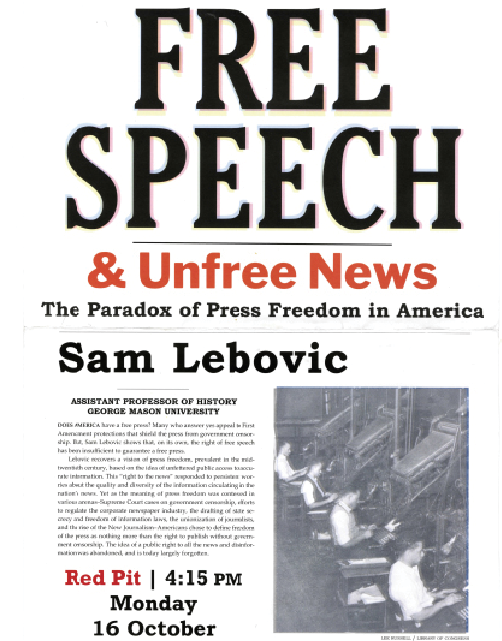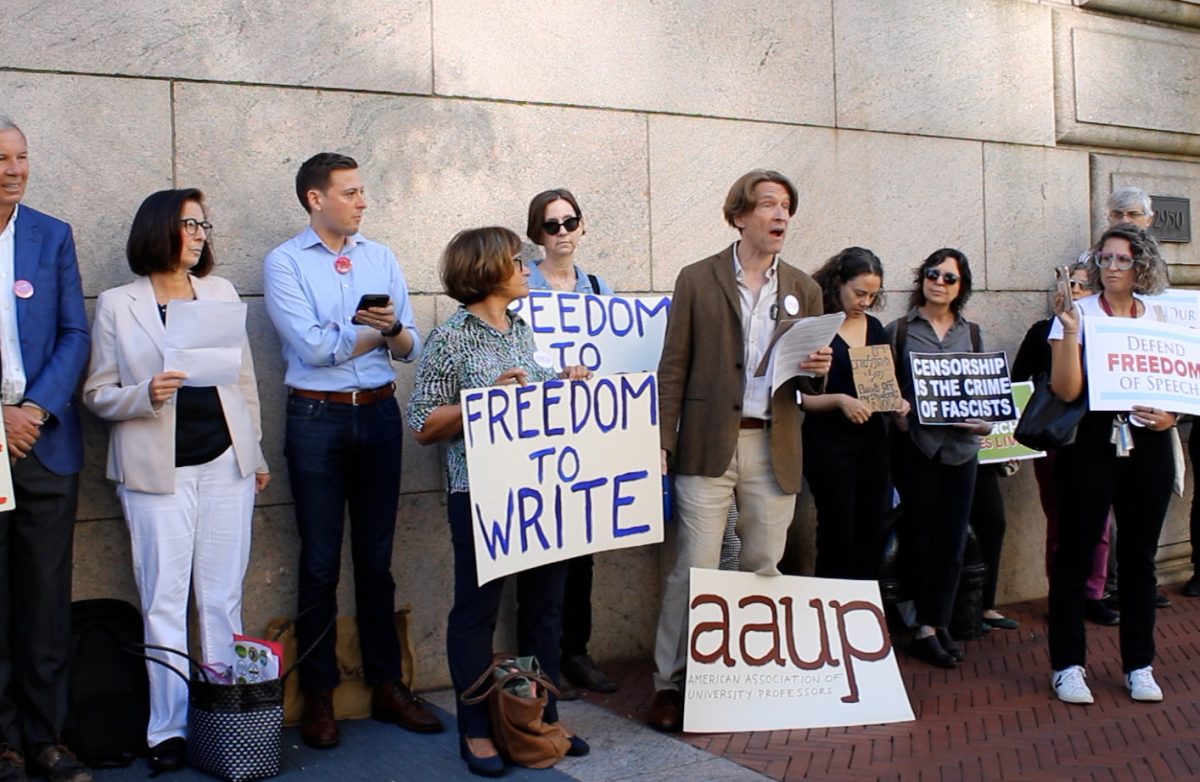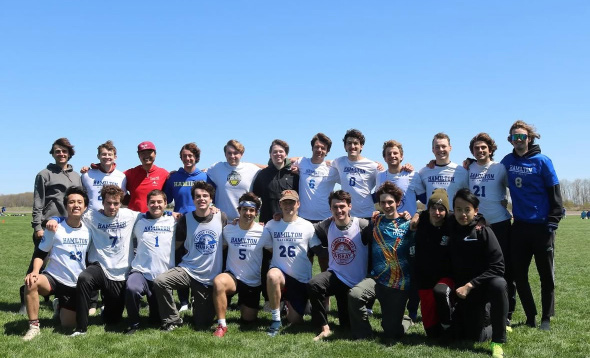
This past Monday, the History Department hosted George Mason University Assistant Professor of History Sam Lebovic.
Lebovic presented a lecture that outlined his recently published book,
Free Speech and Unfree News: The Paradox of Press Freedom in America
. Lebovic’s work won him the Ellis W. Hawley prize, an annual book award which recognizes “the best historical study in the fields of political economy, politics, or institutions within the United States from the Civil War to the present.”
Lebovic began with a fundamental incongruity — the widespread belief that free speech is an untouchable American right, but that it is also “beset by a series of crises.” These are two-fold, encompassing both the crisis of newspaper economics after the advent of the internet as well as the rise of state secrecy. His analysis traces these contemporary trends to the middle decades of the 20th century.
Until 1919, Lebovic explains, Americans did not have a “meaningfully protected” right to free speech. The first amendment protected citizens from Congressional infringements upon their speech liberty, but makes no mention of the authority of the states in this regard.
States had widespread power to regulate speech and press. For example, abolitionist material was censored in the south, while the north banned the publication and distribution of obscene materials (pornography, seditious materials, etc.).
The defining moment of the right to free expression came about in the case of
Abrams v. the United States
, in which Justice Oliver Wendell Holmes defined free, protected speech as that which poses no immediate danger or crime. This is how free speech continues to be understood to this day.
This stagnancy in the conceptualization of free speech is precisely what Lebovic took issue with. How is it possible, he asks, that despite all the changes in the state and newspaper industry, Americans have never adjusted their theories of what exactly constitutes a free press?
What are these visions, and when did they originate? According to Lebovic, there are two visions of the free press engendered within the 20th century. The first conceptualizes this first amendment right as freedom from government intervention. Lebovic terms this a framework of negative liberties — rights that are defined by the absence of certain actions.
The second conceptualization views freedom of expression as a positive right; it is defined not by the absence of government censorship, but instead by the right of access to state secrets, a steady flow of diverse, quality information, produced by journalists who hold themselves to high standards of integrity. This might be more accurately termed the freedom of information.
There have been a variety of ways that Americans in the 20th century have argued over these two visions of free speech -– freedom from censorship vs. freedom to information.
As Lebovic explains, the battle for freedom to information has ultimately lost traction and faded into the background. This has and continues to pose a real threat to society because even though the flow of information has been restricted, there is increasingly less awareness of this fact.
According to Lebovic, two major threats in the realm of the first amendment, as expressed earlier, are the rise of state secrecy and corporate consolidation of the newspaper industry.
Lebovic included a thorough historical context of newspaper consolidation in his lecture, shedding light on the current implications. By the 1930s, the monopoly within the news industry had become a major political problem. Due to rising costs, papers were more expensive to own, which enabled a select few chains to dominate the industry and drive out any potential rivals, who could not afford the overwhelming start-up costs.
Between 1919 and 1942, there was a 14 percent decline in the number of newspapers in the country, despite a 30 percent increase in literacy. In the 1930s, one third of daily circulation was controlled by chains. “This political economy posed a real challenge to democracy,” expressed Lebovic.
The mainstream media was increasingly owned by individual, powerful business people or “newspaper barons,” such as William Randolph Hearst and Frank Gannett. These outlets had an unabashedly conservative tilt, which severely impacted the extent to which they were able to cover current issues in a non-biased fashion, such as Franklin Roosevelt’s New Deal.
In an effort to diversify, break up monopolies, and allow rival points of view to permeate the newspaper industry, various groups worked to regulate the “free” press. The National Recovery Administration proposed a series of economic regulations on the newspaper industry. Moreover, antitrust action was brought against the Associated Press.
In retaliation, the newspaper industry framed these economic regulations as “dictatorial efforts to dominate America’s free press,” an imposition on first amendment rights, and verging on totalitarianism.
However, as Lebovic’s findings might suggest, newspaper corporations were, in fact, the bodies with such dictatorial power. Due to lobbying on the part of the newspaper industry, newspapers succeeded in evading regulation– making it the only industry that was not regulated during the New Deal. Later attempts to use the state as a vehicle for breaking up media monopolies were also met with failure because of a legitimate concern that this would open the door to totalitarianism as well.
The second issue Lebovic contends with is the rise of state secrecy that began during World War II, with the increasing desire to protect state secrets in the interest of national security. These efforts were spearheaded by the Security Advisory Board, which was the first body in charge of looking at national security arrangements.
The Security Advisory Board adopted a framework of “voluntary censorship” in an effort to avoid stifling free speech or regulating the press. At the same time, the passage of Executive Order 1029 made it illegal for federal employees to leak government information; however, if the press gets access to this information, they are able to print it.
As of today, there are 7.5 billion pages classified, which roughly totals the amount of pages in the library of Congress. This, however, is an “insidious” form of censorship because there is no way to know what is classified.
Moreover, there is a tendency on the part of government officials to over-classify so as to avoid liability. Estimates hold that somewhere between 80 and 90 percent of all information that is classified should not have been, suggesting that there is a tremendous disjunction between the information that the public does and should have access to.
Even with the passage of the Freedom of Information Act (FOIA) in 1946, which was mean to increase access public access to this information, this problem has not been resolved — only 6 percent of FOIA requests are made by journalists, as compared to 60 percent of those made by corporations.
In sum, Lebovic concluded that there are no good mechanisms currently in place to deal with the rise of state secrecy and media outlet consolidation, which have collectively contributed to the problem of public accessibility of accurate information.
This problem is only getting worse. According to Lebovic, “we focus so much on right to free expression that the idea that there is actual information upon which these opinions should be based has been lost completely.” It becomes difficult for a democratic citizenship to act in responsible, ethical ways if the information they have access to is of degraded quality.
Lebovic critiques this “deep legacy of under-valuing information” in American politics and urges a reconceptualization of a free press that is not only free from censorship, but also defined by access to diverse information of superior quality. Only then, he suggests, will this first amendment right be vindicated.

















